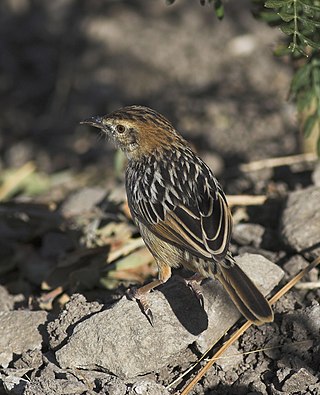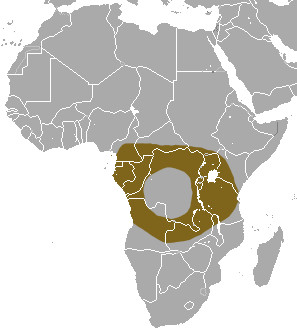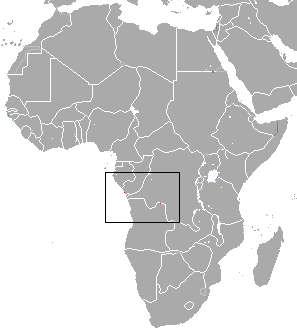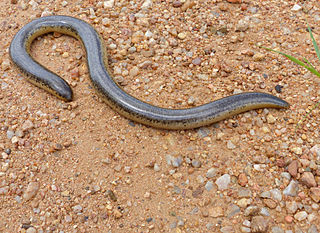The Angolan long-eared bat is a species of vesper bat in the Vespertilionidae family. It can be found in moist savanna in Angola and Democratic Republic of the Congo.
The Angolan multimammate mouse is a species of rodent in the family Muridae. It is found in Angola and Democratic Republic of the Congo. It was formerly classified in the genus Myomyscus but has been reclassified into the genus Mastomys. Its natural habitats are dry savanna and moist savanna.
The common forest tree frog is a species of frog in the family Arthroleptidae found in Angola, Cameroon, the Republic of the Congo, the Democratic Republic of the Congo, Equatorial Guinea, Gabon, Nigeria, and possibly the Central African Republic. Its natural habitats are subtropical or tropical moist lowland forest, subtropical or tropical moist montane forest, subtropical or tropical high-altitude grassland, rivers, intermittent freshwater marshes, and heavily degraded former forests.
The ocellated forest tree frog is a species of frog in the family Arthroleptidae found in Cameroon, the Republic of the Congo, the Democratic Republic of the Congo, Equatorial Guinea, and Gabon, and possibly Angola and the Central African Republic. Its natural habitats are subtropical or tropical moist lowland forest, swamps, and heavily degraded former forests. It is threatened by habitat loss.
The Kala forest tree frog, Leptopelis omissus, is a species of frog in the family Arthroleptidae found in Cameroon, the Republic of the Congo, Gabon, and Nigeria, and possibly Angola, the Central African Republic, the Democratic Republic of the Congo, and Equatorial Guinea. Its natural habitats are subtropical or tropical moist lowland forest, rivers, swamps, freshwater marshes, and heavily degraded former forests. It is threatened by habitat loss.

The Angola river frog, or common river frog, is a species of frog in the family Pyxicephalidae. Formerly, it was placed in the family Ranidae.

Ptychadena oxyrhynchus, commonly known as the South African sharp-nosed frog, is a species of frog in the family Ptychadenidae. It is found in Angola, Benin, Botswana, Cameroon, Central African Republic, Chad, Republic of the Congo, Democratic Republic of the Congo, Ivory Coast, Gambia, Ghana, Guinea, Guinea-Bissau, Kenya, Malawi, Mali, Mozambique, Namibia, Nigeria, Senegal, South Africa, Swaziland, Tanzania, Togo, Uganda, Zambia, Zimbabwe, possibly Burkina Faso, possibly Burundi, possibly Niger, possibly Rwanda, and possibly Sudan.

The Angola lark or Angola bushlark is a species of lark in the family Alaudidae found in southern and central Africa.

The black-and-white shrike-flycatcher, also known as the black-and-white flycatcher or vanga flycatcher, is a species of passerine bird found in Africa. It was placed with the wattle-eyes and batises in the family Platysteiridae but is now considered to be more closely related to the helmetshrikes and woodshrikes.

The purple-throated cuckooshrike is a species of bird in the family Campephagidae. It is found in Angola, Benin, Cameroon, Central African Republic, Republic of the Congo, Democratic Republic of the Congo, Ivory Coast, Equatorial Guinea, Gabon, Ghana, Guinea, Kenya, Liberia, Mali, Nigeria, Sierra Leone, South Sudan, Tanzania, Togo, Uganda, and Zambia. Its natural habitats are subtropical or tropical dry forest, subtropical or tropical moist lowland forest, and subtropical or tropical moist montane forest.

The stout cisticola is a species of bird in the family Cisticolidae. It is found in Angola, Burundi, Cameroon, Republic of the Congo, Democratic Republic of the Congo, Eritrea, Ethiopia, Kenya, Nigeria, Rwanda, South Sudan, Tanzania, Uganda, and Zambia. Its natural habitats are boreal forest, moist savanna, and subtropical or tropical high-altitude grassland.

The Angola swallow is a species of swallow that is native to the Afrotropics.

The African pitta is an Afrotropical bird of the family Pittidae. It is a locally common to uncommon species, resident and migratory in the west, and an intra-African migrant between equatorial and southeastern Africa. They are elusive and hard to observe despite their brightly coloured plumage, and their loud, explosive calls are infrequently heard. The plump, somewhat thrush-like birds forage on leaf litter under the canopy of riparian or coastal forest and thickets, or in climax miombo forest. They spend much time during mornings and at dusk scratching in leaf litter or around termitaria, or may stand motionless for long periods. Following rains breeding birds call and display from the mid-canopy.

Fraser's rufous thrush, also known as the rufous flycatcher-thrush, is a species of bird in the thrush family.

The turbo shrew is a species of mammal in the family Soricidae. It is found in Angola, Burundi, Cameroon, Central African Republic, Republic of the Congo, Democratic Republic of the Congo, Equatorial Guinea, Gabon, Kenya, Malawi, Rwanda, South Sudan, Tanzania, Uganda, and Zambia. Its natural habitats are subtropical or tropical moist lowland and montane forests.

The climbing shrew is a species of mammal in the family Soricidae, which is found in subtropical Africa. It is found in Angola, Benin, Burundi, Cameroon, Central African Republic, Republic of the Congo, Democratic Republic of the Congo, Ivory Coast, Ethiopia, Ghana, Guinea, Kenya, Liberia, Malawi, Mozambique, Nigeria, Rwanda, Sierra Leone, South Sudan, Tanzania, Togo, Uganda, Zambia, and Zimbabwe. Its natural habitats are subtropical or tropical moist lowland and montane forests, and moist savanna.

The lesser Angolan epauletted fruit bat is a species of megabat in the family Pteropodidae. It is found in Angola and the Republic of the Congo. Its natural habitats are subtropical or tropical dry and moist lowland forest, and savanna.

The Angolan fruit bat, Angolan rousette or silky bat is a species of megabat in the family Pteropodidae. It is found in Angola, Burundi, Cameroon, Central African Republic, Republic of Congo, Democratic Republic of Congo, Kenya, Nigeria, Rwanda, Sudan, Tanzania, Uganda, and Zambia. Its natural habitats are subtropical or tropical moist lowland forest, moist savanna, and rocky areas.

The little collared fruit bat is a species of megabat in the family Pteropodidae found in Angola, Cameroon, the Central African Republic, the Republic of the Congo, the Democratic Republic of the Congo, Ivory Coast, Equatorial Guinea, Gabon, Ghana, Guinea, Liberia, Nigeria, Rwanda, Sierra Leone, South Sudan, Togo, and Uganda. Its natural habitats are subtropical or tropical moist lowland forests and moist savanna.

Afrotyphlops is a genus of snakes in the family Typhlopidae.















